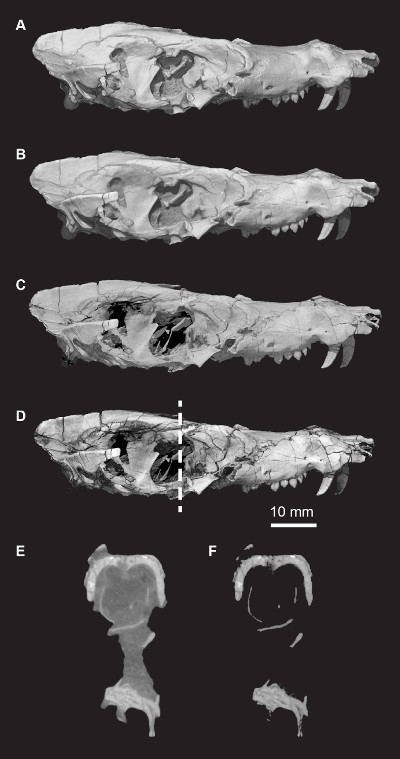 An article published in the journal “PLOS ONE” reports the identification of a new species of cynodont that lived in today’s Argentina about 230 million years ago, in the Late Triassic period. A team of researchers subjected a fossil skull to a high-resolution micro-CT scan to study it in detail and named it Pseudotherium argentinus. Its look made paleontologist Ricardo Martínez compare it to Scrat, a squirrel among the characters in the movie “Ice Age”.
An article published in the journal “PLOS ONE” reports the identification of a new species of cynodont that lived in today’s Argentina about 230 million years ago, in the Late Triassic period. A team of researchers subjected a fossil skull to a high-resolution micro-CT scan to study it in detail and named it Pseudotherium argentinus. Its look made paleontologist Ricardo Martínez compare it to Scrat, a squirrel among the characters in the movie “Ice Age”.
The fossil skull object of this research was found in 2006 in the Ischigualasto Formation in Argentina together with many other fossils that include other cynodonts but also many other species belonging to various groups. After a phase of manual preparation that allowed much of the skull’s surface to be exposed, the researchers proceeded with a high-resolution micro-CT scan that made it possible to create a 3D reproduction.
The image (Rachel VS Wallace, Ricardo Martínez, Timothy Rowe. https://doi.org/10.1371/journal.pone.0218791.g002 ) shows a comparison among different methods of processing of the Pseudotherium argentinus skull’s image obtained thanks to the micro-TAC.
The study of Pseudotherium argentinus is limited by the availability of a single specimen’s skull only, however the researchers were able to examine the characteristics of the available parts and compare them with those of other cynodonts and mammals as well. There’s a particular interest in reconstructing the history of therapsids, the large group that includes cynodonts and mammals, so each new discovery can offer important information.
Pseudotherium argentinus was a small animal, with a skull about 7 centimeters long and an estimated total length of 25 centimeters. The skull allowed to study its long, flat snout endowed with long teeth that were probably useful for it to grab the insects it ate. There’s also the possibility that the specimen discovered was a male and the long teeth were also a sexual attraction for females but it’s a hypothesis and Dr. Ricardo Martínez stressed the fact that having only one specimen they can’t say much about it.
Subjecting the Pseudotherium argentinus skull to a high-resolution micro-CT scan it was still possible to obtain a 3D reconstruction which allowed to study its internal structures. The researchers noted characteristics such as the developed inner ear and parts of the respiratory system that suggest this cynodont was warm-blooded.
Some characteristics of Pseudotherium argentinus remind of those of the Mammaliaformes, a group of cynodonts that includes mammals and is part of the larger Mammaliamorpha group. Understanding the relationships among the various groups of therapsids is the goal of all researchers who carried out studies on fossils belonging to one of them.
In the field of paleontology they often have to deal with a limited availability of fossils, in many cases only partial ones, so every new discovery is useful. For this reason, the authors of the research on Pseudotherium argentinus made the set of data obtained from the micro-TAC publicly available hoping that this type of examination will be extended to more therapsid fossils. These modern technologies are being used more and more by paleontologists and are proving very useful to obtain new information even from fossils already studied in the past.

